Testing Platforms as Drivers for Positive-Energy Living Laboratories
Abstract
1. Introduction
2. Materials and Methods
- Be flexible to allow the integration of different solutions.
- Take into account energy, social, environmental or economical aspects.
- Monitor the performance of a district solution under real conditions of use.
- Quantify the main fluxes that contribute to the studied configuration.
3. Results
3.1. Case Studies
3.2. Climate Conditions
- Zone BSk is defined as cold and semi-arid climate. These zones are characterized by warm to hot dry summers and cold winters. The precipitation patterns for regions with higher latitudes correspond to dry winters and wetter summers. The precipitation patterns for regions with lower latitudes correspond to dry summers, relatively wet winters, and wetter springs and autumns. Only the city of Zaragoza in Spain is available in this climatic zone.
- Zone Csa is defined as hot-summer Mediterranean climate. These zones are characterized by hot and dry summers and mild and wet winters. Four Spanish regions are available in this climatic zone: Barcelona, Girona, Madrid, and Tarragona.
- Zone Cfb is defined as temperate oceanic climate. These zones are characterized by moderate temperature along the year, absence of a dry season and constant precipitation especially during the colder months. Three countries are available in this climatic zone: Spain (Soria and Pamplona), Belgium (Dilsen-Stokkem, Ghent, and Genk), and the Czech Republic (Buštěhrad).
- Zone Csb is defined as warm-summer Mediterranean climate. These zones are characterized by warm and dry summers and wet winters with temperatures that vary from mild to chilly climates. Only the city of Lisbon in Portugal is available in this climatic zone.
- Zone Dfb is defined as warm summer and humid continental climate. These zones, known as hemiboreal zones, are characterized by warm to hot and humid summers and cold winters (sometimes severe cold in northern areas). Precipitation is distributed throughout the year. Only the city of Espoo in Finland is available in this climatic zone.
- Zone Dfc is defined as subarctic climate. These zones are characterized by long and very cold winters and short summers with temperatures that vary from cold to mild climates. In these regions, there is no dry season and there are no significant seasonal differences in precipitation. Only the city of Trondheim in Norway is available in this climatic zone.
3.3. Scale of Action
- Building scale (green area). These facilities consider the building as a very small-scale urban experimental laboratory where energy exchanges between the building and its surrounding environment can be controlled. In these installations, the boundary conditions, as well as the building energy fluxes, are evaluated to identify the relevant flows that will affect the district scale. The ZEB lab is shown in Figure 6 as an example of the building scale.
- Campus scale (blue area). This scale represents a testing district facility that operates under controlled conditions. These laboratories consider some elements of the district model such as buildings and conditioning networks, in which the energy fluxes are evaluated in a controlled manner. Several batteries of experiments can be performed to reproduce specific situations. The facilities of EnergyVille placed in Belgium are shown in Figure 7 as an example of this scale.
- Urban scale (purple area). This scale represents urban testing facilities operating under real conditions of use. Buildings, thermal networks, electrical networks or open spaces are elements of these laboratories. In these laboratories, all the urban interactions between people, buildings, and systems are represented, but not all of them can be controlled and calculated. The Lippulaiva lab is shown in Figure 8 as an example of the urban scale.
- Virtual scale (orange area). This scale represents a laboratory that can operate under real or simulated conditions of use. These facilities allow the evaluation of several urban fluxes, but high computing requirements are needed. Real measurements of different elements must feed these platforms to represent the urban energy fluxes correctly. The semi virtual SEILAB facility is shown in Figure 9 as an example of this scale.
3.4. Facility Application
- Social aspects. The interactions between humans and their environment can be analyzed as an urban issue in the existing facilities.
- ICT/control. These laboratories assess the performance of control systems and technologies of information and communication.
- Outdoor climate conditions. The ambient climate conditions of the district can be evaluated through experimental devices.
- Indoor climate conditions. The ambient conditions inside the buildings can be monitored through the integration of experimental devices.
- Energy loads. The building performance can be quantified through the energy loads calculation. Two types can be evaluated: Thermal and electrical loads.
- Electrical vehicle. The interactions between electrical vehicles, buildings, and grids can be assessed through electrical mobility facilities.
- Lighting systems. The operation of artificial lighting systems produced in the district can be analyzed and regulated through different equipment.
- Energy networks. The energy interaction between the generation sources, distribution networks, and consumption points can be evaluated through the use of different devices. Two district types can be evaluated: Thermal (heating and cooling) and electrical networks.
- Storage elements. The fluctuations produced between the energy production and the demand side can be evaluated through the energy performance of the storage systems. Two types can be evaluated: Thermal and electrical storage.
- Water systems. The performance of water recovery systems or treatment of water can be assessed by means of different devices in the existing facilities.
- Waste treatments. These laboratories evaluate different solutions to minimize the urban waste and increase the environmental conditions.
3.5. Characteristics of Laboratories according to the Scale of Action
3.5.1. Building Scale
3.5.2. Campus Scale
3.5.3. Urban Scale
3.5.4. Virtual Scale
3.6. SWOT Analysis
- High climatic representativeness of Europe.
- Availability of different scales of action for the studied laboratories, allowing the assessment of several urban flows.
- Availability of measurements in real conditions of use and in virtual conditions.
- Availability of different technologies for the use of laboratories: Energy, social, e-mobility, ...
- Possibility of evaluating urban configurations that integrate various types of uses.
- Availability of different types of buildings, energy systems, and storage systems.
- High representativeness of renewable technologies.
- High generation potential of renewable technologies.
- Availability of other types of technologies such as cogeneration or Stirling engines.
- Diversification of energy generation and consumption due to the competitiveness of generation technologies and energy efficiency measures.
- Few laboratories available for the analysis sample. To raise the representativeness of the study, more cases should be added.
- Absence of extreme weather conditions: Tropical (climate zone A) and polar (climate zone E).
- Necessity to expand the climate applicability of this study. More dry (B zones) and continental (D zones) regions should be included.
- More virtual laboratories are needed.
- Low availability of laboratories that include social aspects, water, and waste flows.
- More cases of some renewable technologies should be included into the sample: Solar thermal technologies, wind turbines or biomass boilers.
- Gap between theoretical models and real situations of certain systems due to the lack of validation based on real data.
- Technical aspects in order to optimize the management of a combined configuration.
- Administrative, regulatory, and normative barriers can be found for the optimal operation of the laboratory.
- Absence of experimental analysis protocols for high scales of action.
- Quantification of several urban flows thanks to the availability of different scales of action laboratories.
- Evaluation of the energy balance for combined urban solutions.
- Integrated management optimization for the resources and services of a district.
- Development of virtual PED labs to assess configurations that integrate different urban aspects.
- Helping tools to increase the decarbonization of the districts through sustainable models with a favorable impact on the quality of life of citizens.
- Optimization of solutions that promote the efficient renovation of the building stock and the optimization of public infrastructures.
- Improvement in the comfort perception and the environmental conditions in urban districts.
- Evaluate, under controlled conditions, the joint participation of different stakeholders for the development of positive-energy districts.
- Creation of qualified jobs.
- Deviation in the obtained results due to the absence of measure protocols for PED labs.
- More regulatory barriers for urban large-scale laboratories.
- Need for flexible and efficient networks connected to the living labs.
- Administrative problems for urban large-scale laboratories due to data protection laws.
- Necessary investment for the implementation of some technologies and infrastructures.
- Legal barriers to construct an urban large-scale laboratory.
- Difficulty of defining a large-scale laboratory due to the existing urban layout in cities.
- Social lack of knowledge for the benefits produced by urban large-scale laboratories.
4. Discussion
5. Conclusions
Author Contributions
Funding
Acknowledgments
Conflicts of Interest
References
- European Commission. The Strategic Energy Technology Plan—At the Heart of Energy Research and Innovation in Europe; Communication from the Commission: Brussels, Belgium, 2018; ISBN 978-92-79-77316-7. [Google Scholar]
- United Nations. Department of Economic and Social Affairs, Population Division. In World Urbanization Prospects: The 2018 Revision; ST/ESA/SER.A/420; United Nations: New York, NY, USA, 2019; ISBN 978-92-1-148319-2. [Google Scholar]
- Balaras, C.A.; Droutsa, K.G.; Dascalaki, E.; Kontoyiannidis, S.; Moro, A.; Bazzan, E. Urban Sustainability Audits and Ratings of the Built Environment. Energies 2019, 12, 4243. [Google Scholar] [CrossRef]
- Sustainable Development—17 Goals to Transform Our World. United Nations. Available online: https://www.un.org/sustainabledevelopment/ (accessed on 30 September 2020).
- European Commission. The European Green Deal, Volume 53. 2019. Available online: https://eur-lex.europa.eu/legal-content/EN/TXT/HTML/?uri=CELEX:52019DC0640&from=EN (accessed on 30 September 2020).
- Fabbri, M.; DeGroote, M.; Rapf, O. Building Renovation Passports: Customised Roadmaps towards Deep Renovation and Better Homes; Buildings Performance Institute European: Brussels, Belgium, 2016; Volume 46, ISBN 9789491143175. [Google Scholar]
- Cartalis, C.; Synodinou, A.; Proedrou, M.; Tsangrassoulis, A.; Santamouris, M. Modifications in energy demand in urban areas as a result of climate changes: An assessment for the southeast Mediterranean region. Energy Convers. Manag. 2001, 42, 1647–1656. [Google Scholar] [CrossRef]
- Sánchez, M.; Soutullo, S.; Olmedo, R.; Bravo, D.; Castaño, S.; Jiménez, M. An experimental methodology to assess the climate impact on the energy performance of buildings: A ten-year evaluation in temperate and cold desert areas. Appl. Energy 2020, 264, 114730. [Google Scholar] [CrossRef]
- Pacheco, R.; Ordonez, J.; Martinez, G. Energy efficient design of building: A review. Renew. Sustain. Energy Rev. 2012, 16, 3559–3573. [Google Scholar] [CrossRef]
- Kheiri, F. A review on optimization methods applied in energy-efficient building geometry and envelope design. Renew. Sustain. Energy Rev. 2018, 92, 897–920. [Google Scholar] [CrossRef]
- Cao, X.; Dai, X.; Liu, J. Building energy-consumption status worldwide and the state-of-the-art technologies for zero-energy buildings during the past decade. Energy Build. 2016, 128, 198–213. [Google Scholar] [CrossRef]
- Rezaie, B.; Rosen, M.A. District heating and cooling: Review of technology and potential enhancements. Appl. Energy 2012, 93, 2–10. [Google Scholar] [CrossRef]
- Taleghani, M.; Tenpierik, M.; Kurvers, S.S.R.; Dobbelsteen, A.V.D. A review into thermal comfort in buildings. Renew. Sustain. Energy Rev. 2013, 26, 201–215. [Google Scholar] [CrossRef]
- Yang, W.; Moon, H.J. Combined effects of acoustic, thermal, and illumination conditions on the comfort of discrete senses and overall indoor environment. Build. Environ. 2019, 148, 623–633. [Google Scholar] [CrossRef]
- Heibati, S.; Maref, W.; Saber, H.H. Assessing the Energy and Indoor Air Quality Performance for a Three-Story Building Using an Integrated Model, Part One: The Need for Integration. Energies 2019, 12, 4775. [Google Scholar] [CrossRef]
- Reynders, G.; Lopes, R.A.; Marszal-Pomianowska, A.; Aelenei, D.; Martins, J.; Saelens, D. Energy flexible buildings: An evaluation of definitions and quantification methodologies applied to thermal storage. Energy Build. 2018, 166, 372–390. [Google Scholar] [CrossRef]
- Eshraghi, A.; Salehi, G.; Heibati, S.; Lari, K. An enhanced operation model for energy storage system of a typical combined cool, heat and power based on demand response program: The application of mixed integer linear programming. Build. Serv. Eng. Res. Technol. 2018, 40, 47–74. [Google Scholar] [CrossRef]
- Calise, F.; D’Accadia, M.D.; Piacentino, A. Exergetic and exergoeconomic analysis of a renewable polygeneration system and viability study for small isolated communities. Energy 2015, 92, 290–307. [Google Scholar] [CrossRef]
- Hiremath, R.; Shikha, S.; Ravindranath, N. Decentralized energy planning; modeling and application—A review. Renew. Sustain. Energy Rev. 2007, 11, 729–752. [Google Scholar] [CrossRef]
- Drysdale, D.; Jensen, L.K.; Mathiesen, B. Energy Vision Strategies for the EU Green New Deal: A Case Study of European Cities. Energies 2020, 13, 2194. [Google Scholar] [CrossRef]
- Macedo, J.; Rodrigues, F.; Tavares, F. Urban sustainability mobility assessment: Indicators proposal. Energy Procedia 2017, 134, 731–740. [Google Scholar] [CrossRef]
- Lindenau, M.; Böhler-Baedeker, S. Citizen and Stakeholder Involvement: A Precondition for Sustainable Urban Mobility. Transp. Res. Procedia 2014, 4, 347–360. [Google Scholar] [CrossRef]
- Serna, A.; Gerrikagoitia, J.K.; Bernabé, U.; Ruiz, T. Sustainability analysis on Urban Mobility based on Social Media content. Transp. Res. Procedia 2017, 24, 1–8. [Google Scholar] [CrossRef]
- European Environment Agency. Air Quality in Europe—2018 Report. Available online: https://www.eea.europa.eu/publications/air-quality-in-europe-2018 (accessed on 30 September 2020).
- Morawska, L.; Thai, P.K.; Liu, X.; Asumadu-Sakyi, A.; Ayoko, G.; Bartonova, A.; Bedini, A.; Chai, F.; Christensen, B.; Dunbabin, M.; et al. Applications of low-cost sensing technologies for air quality monitoring and exposure assessment: How far have they gone? Environ. Int. 2018, 116, 286–299. [Google Scholar] [CrossRef]
- Martínez-Bravo, M.M.; Martínez-del-Río, J.; Antolín-López, R. Trade-offs among urban sustainability, pollution and livabiity in European cities. J. Clean. Prod. 2019, 224, 651–660. [Google Scholar] [CrossRef]
- Van Broekhoven, S.; Vernay, A.L. Integrating Functions for a Sustainable Urban System: A Review of Multifunctional Land Use and Circular Urban Metabolism. Sustainability 2018, 10, 1875. [Google Scholar] [CrossRef]
- Ferreira, V.; Barreira, A.P.; Loures, L.; Antunes, D.; Panagopoulos, T. Stakeholders’ Engagement on Nature-Based Solutions: A Systematic Literature Review. Sustainability 2020, 12, 640. [Google Scholar] [CrossRef]
- Margerum, R.D. Evaluating Collaborative Planning:Implications from an Empirical Analysis of Growth Management. J. Am. Plan. Assoc. 2002, 68, 179–193. [Google Scholar] [CrossRef]
- Concerto European Initiative. Available online: https://www.concertoplus.eu/ (accessed on 30 September 2020).
- Horizon. 2020. Available online: https://ec.europa.eu/programmes/horizon2020/en (accessed on 30 September 2020).
- SET-Plan Working Group. Europe to Become a Global Role Model in Integrated, Innovative Solutions for the Planning, Deployment, and Replication of Positive Energy Districts. SET-Plan Action No 32 Implement Plan, 1–72. 2018. Available online: https://setis.ec.europa.eu/system/files/setplan_smartcities_implementationplan.pdf (accessed on 30 September 2020).
- Ferrara, M.; Monetti, V.; Fabrizio, E. Cost-Optimal Analysis for Nearly Zero Energy Buildings Design and Optimization: A Critical Review. Energies 2018, 11, 1478. [Google Scholar] [CrossRef]
- Sartori, I.; Napolitano, A.; Voss, K. Net zero energy buildings: A consistent definition framework. Energy Build. 2012, 48, 220–232. [Google Scholar] [CrossRef]
- Magrini, A.; Lentini, G.; Cuman, S.; Bodrato, A.; Marenco, L. From nearly zero energy buildings (NZEB) to positive energy buildings (PEB): The next challenge—The most recent European trends with some notes on the energy analysis of a forerunner PEB example. Dev. Built Environ. 2020, 3, 100019. [Google Scholar] [CrossRef]
- Marique, A.-F.; Reiter, S. A simplified framework to assess the feasibility of zero-energy at the neighbourhood/community scale. Energy Build. 2014, 82, 114–122. [Google Scholar] [CrossRef]
- Amaral, A.R.; Rodrigues, E.; Gaspar, A.R.; Gomes, Á. Review on performance aspects of nearly zero-energy districts. Sustain. Cities Soc. 2018, 43, 406–420. [Google Scholar] [CrossRef]
- JPI Urban Europe. Available online: https://jpi-urbaneurope.eu/ (accessed on 30 September 2020).
- European Energy Research Alliance (EERA). Available online: www.eera-set.eu/ (accessed on 30 September 2020).
- EERA. Joint Programme on Smart Cities. Available online: www.eera-sc.eu/ (accessed on 30 September 2020).
- Köppen, W.; Geiger, R. Das Geographische System der Klimate. Handbuch der Klimatologie; Bulletin of the American Geographical Society: Berlin, Germany, 1936; Volume 43, Available online: http://koeppen-geiger.vu-wien.ac.at/pdf/Koppen_1936.pdf (accessed on 30 September 2020).
- Vetme University of Wien. Available online: http://koeppen-geiger.vu-wien.ac.at/ (accessed on 30 September 2020).
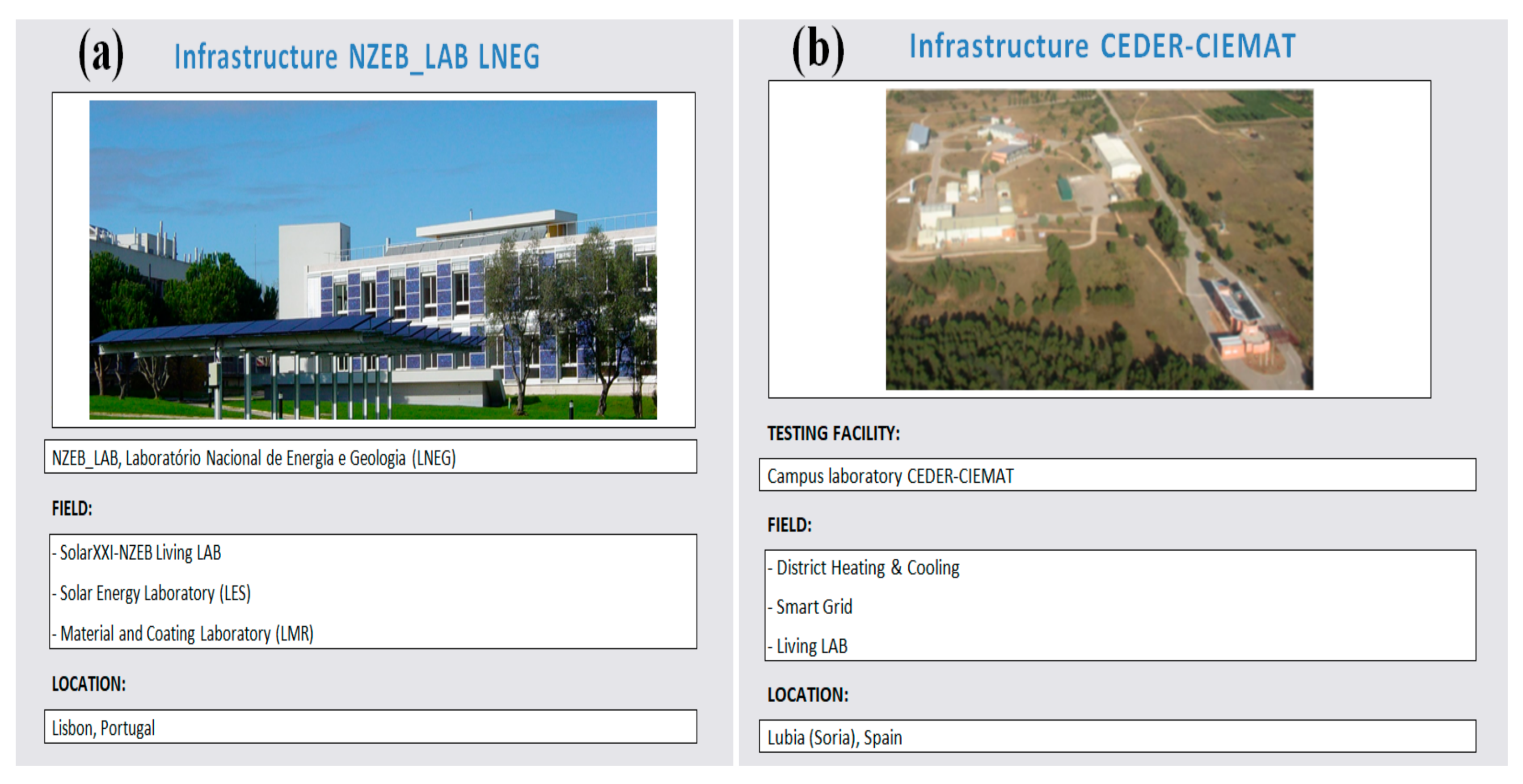
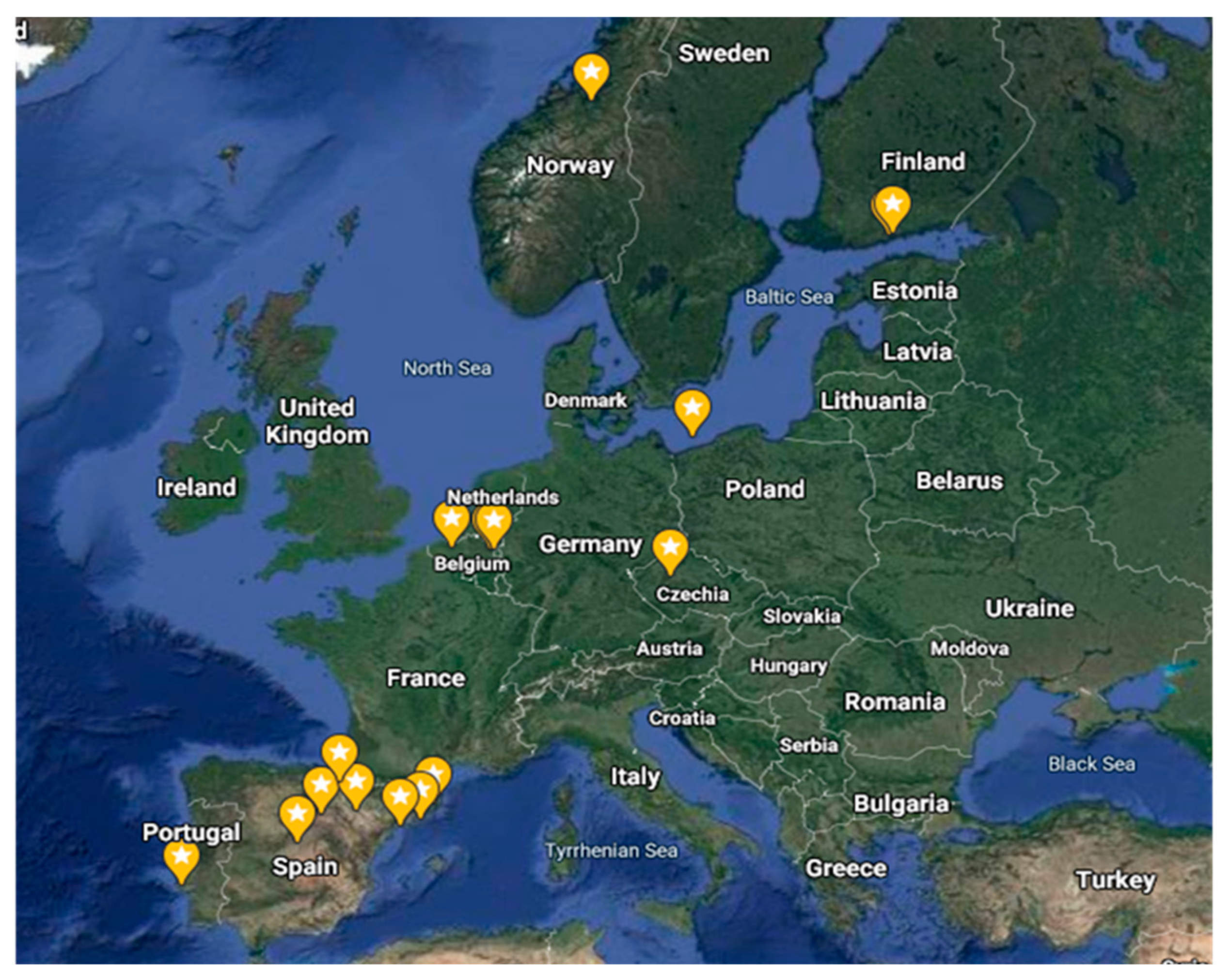
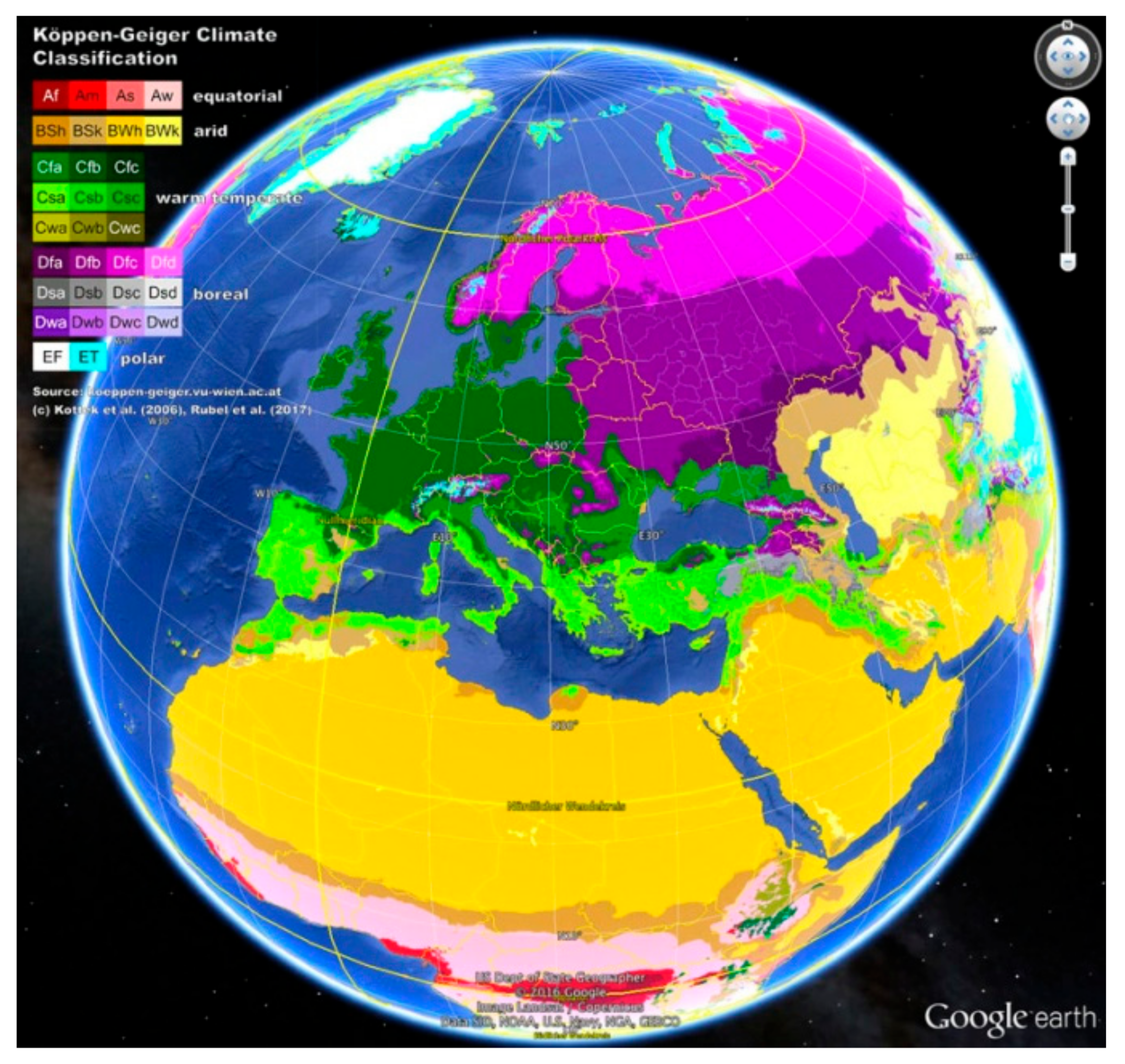
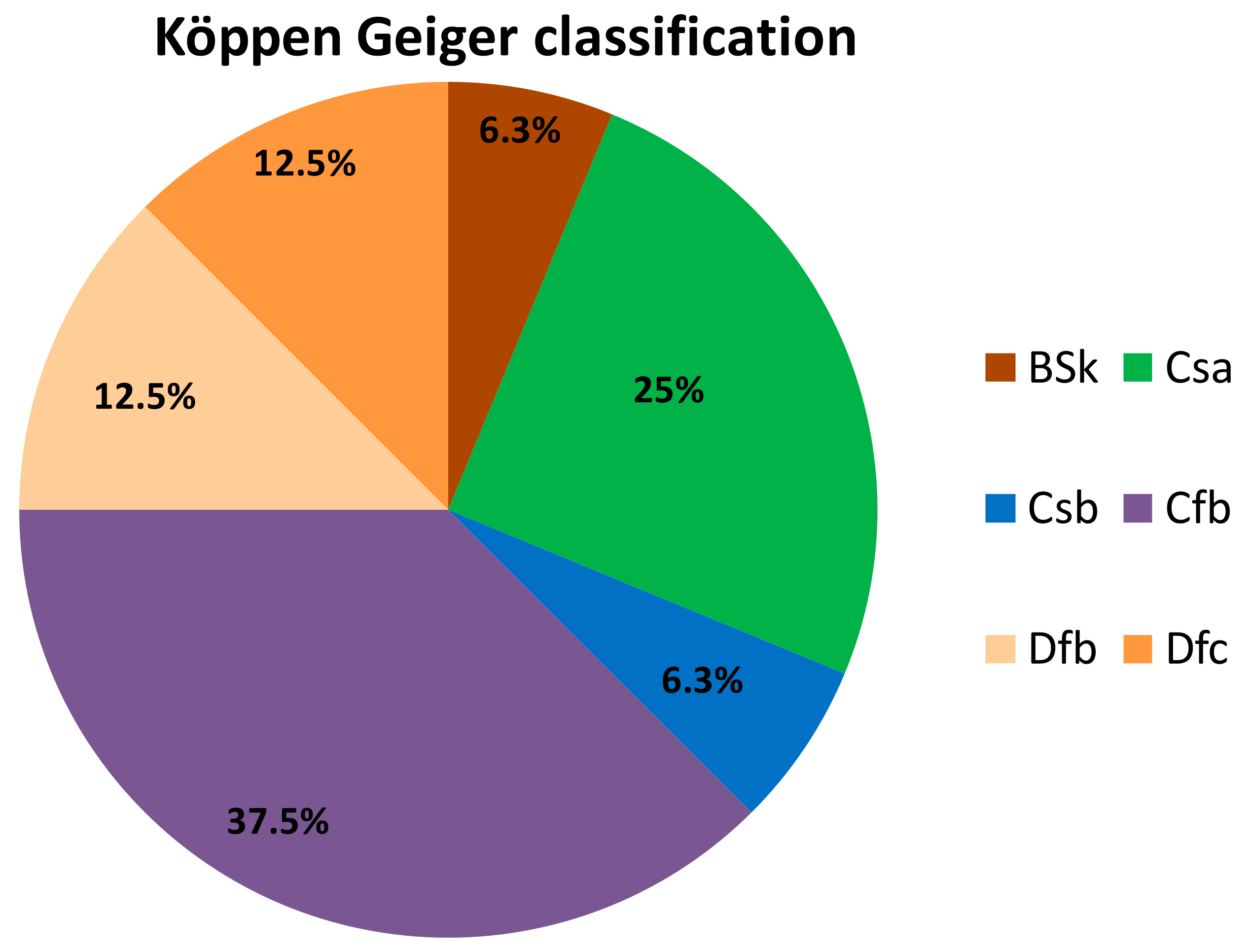
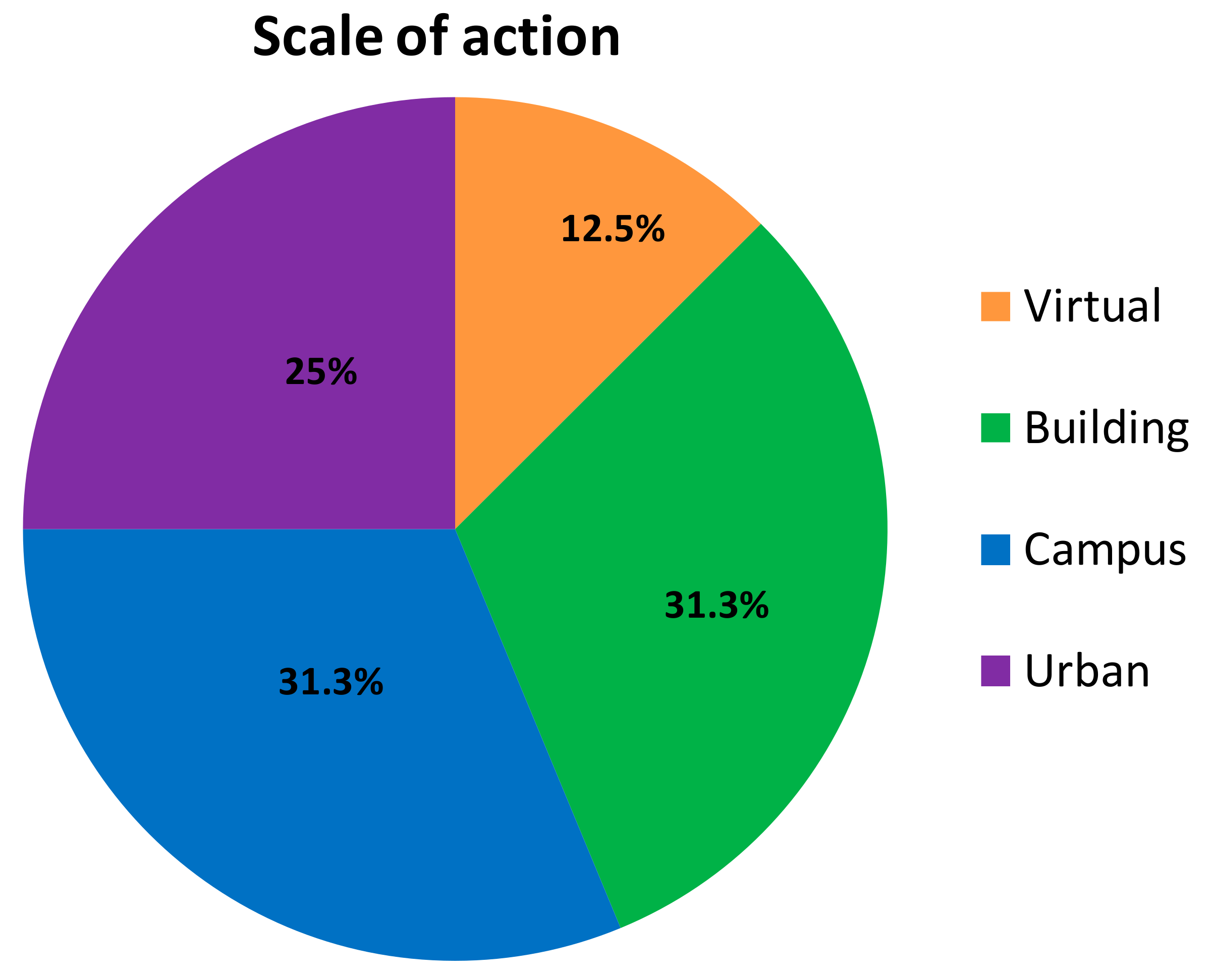
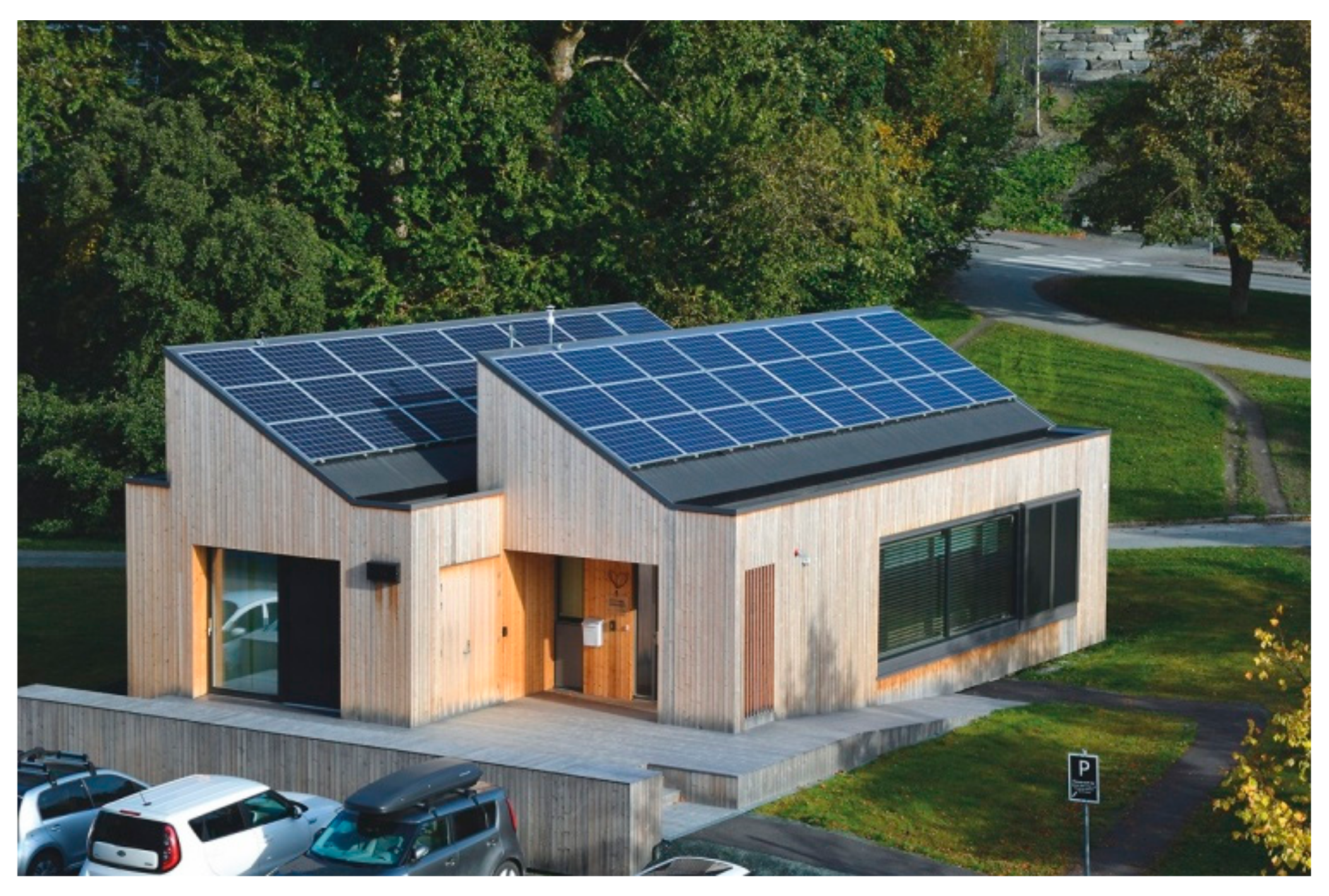
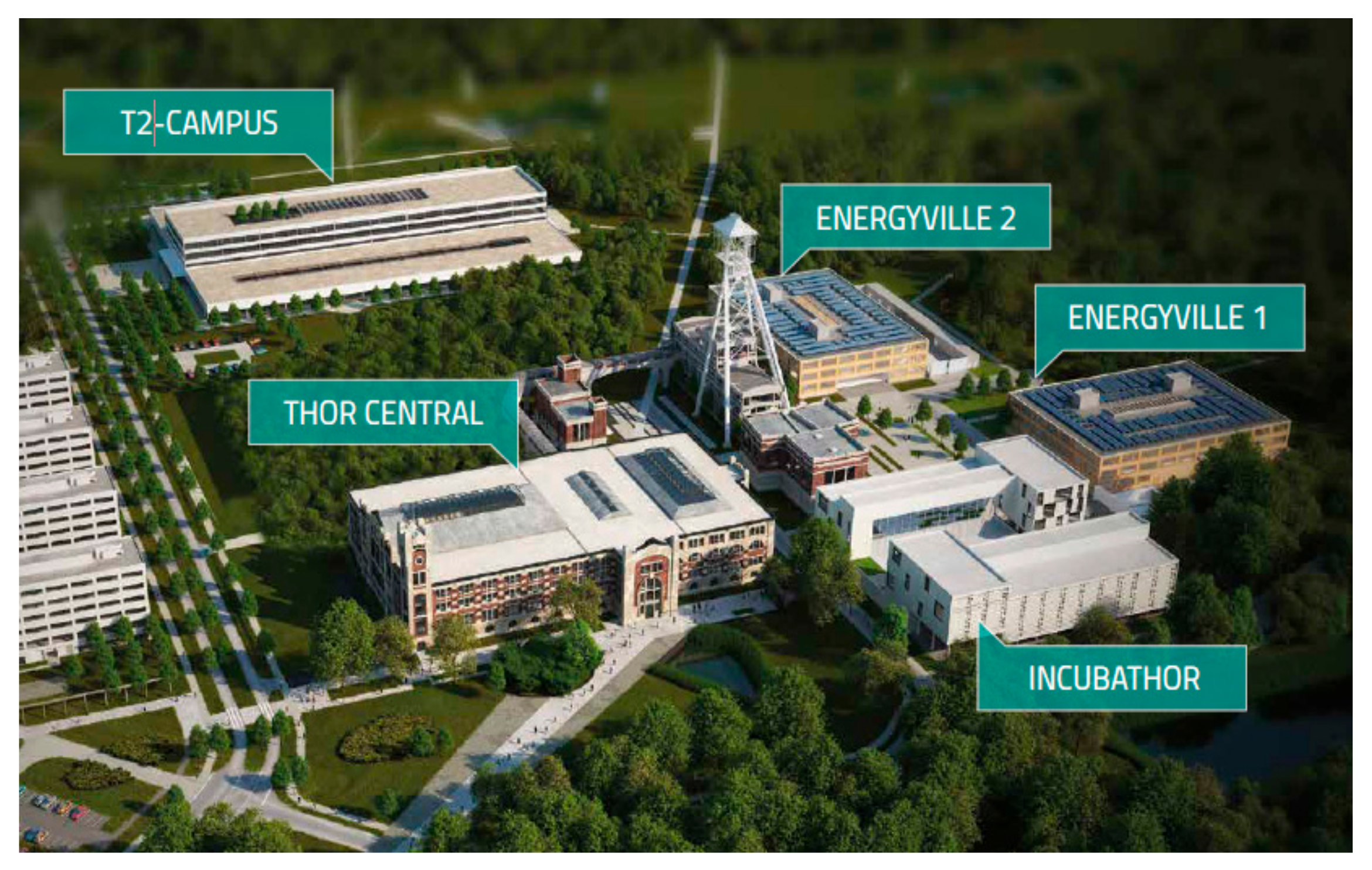
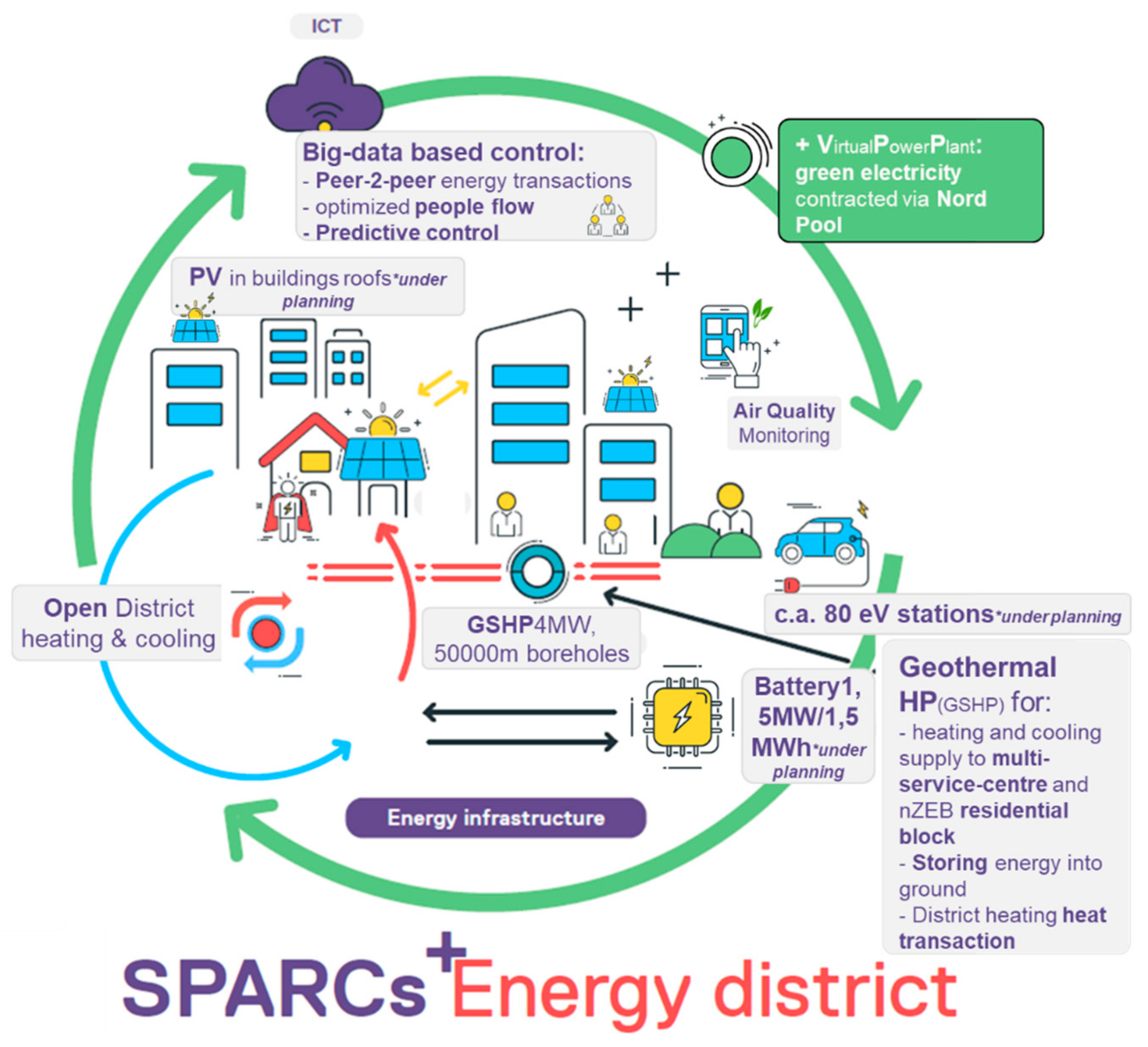
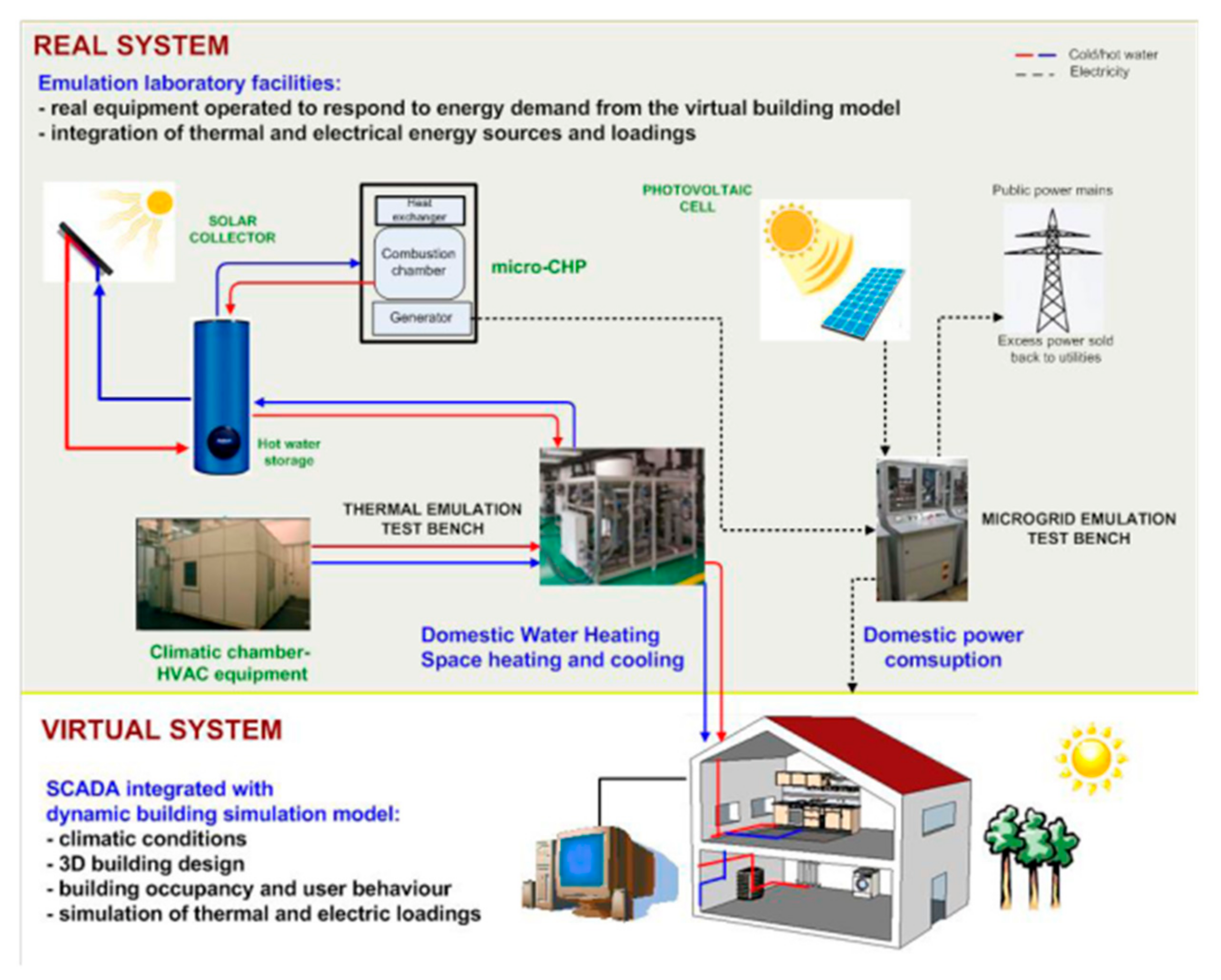
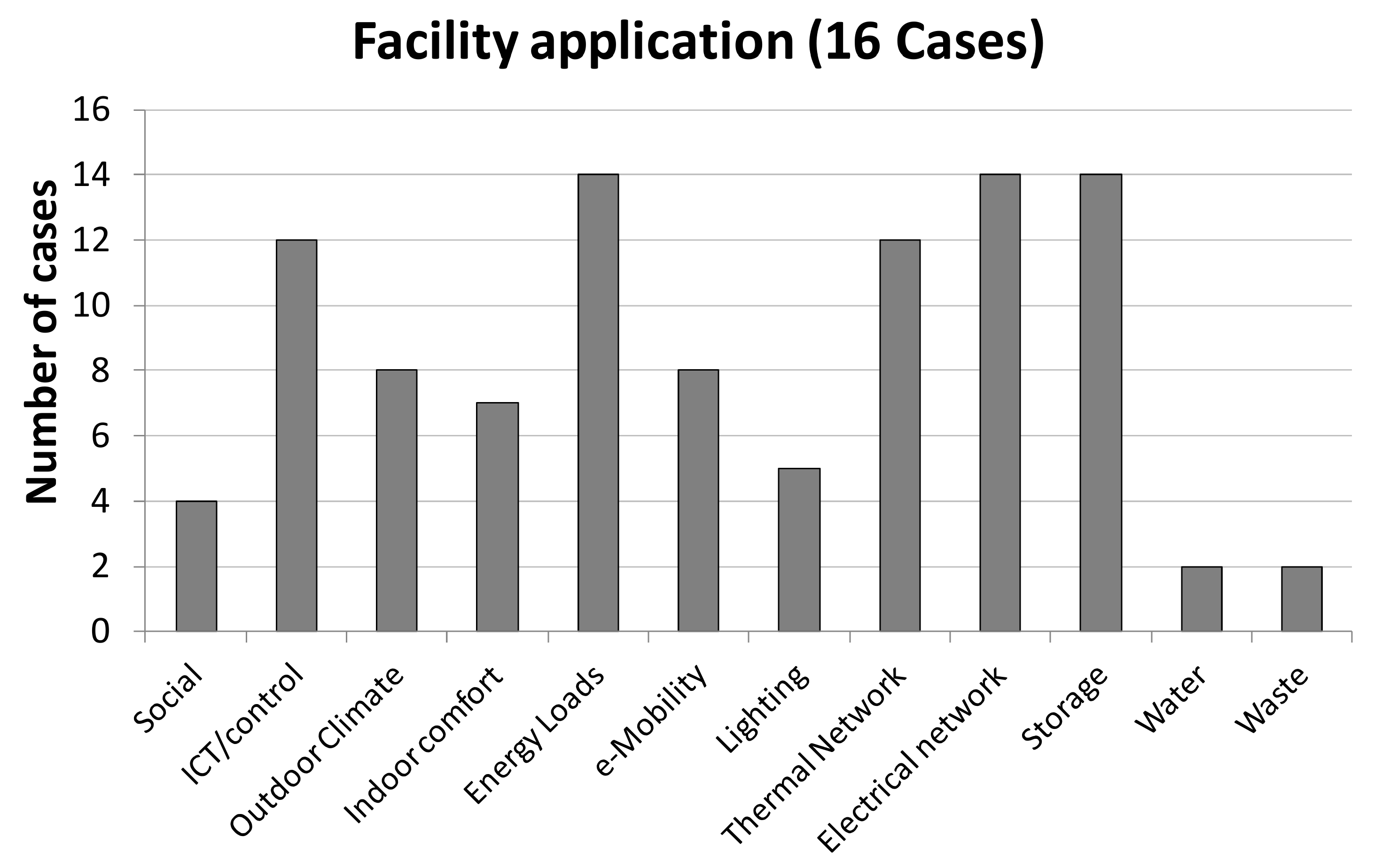

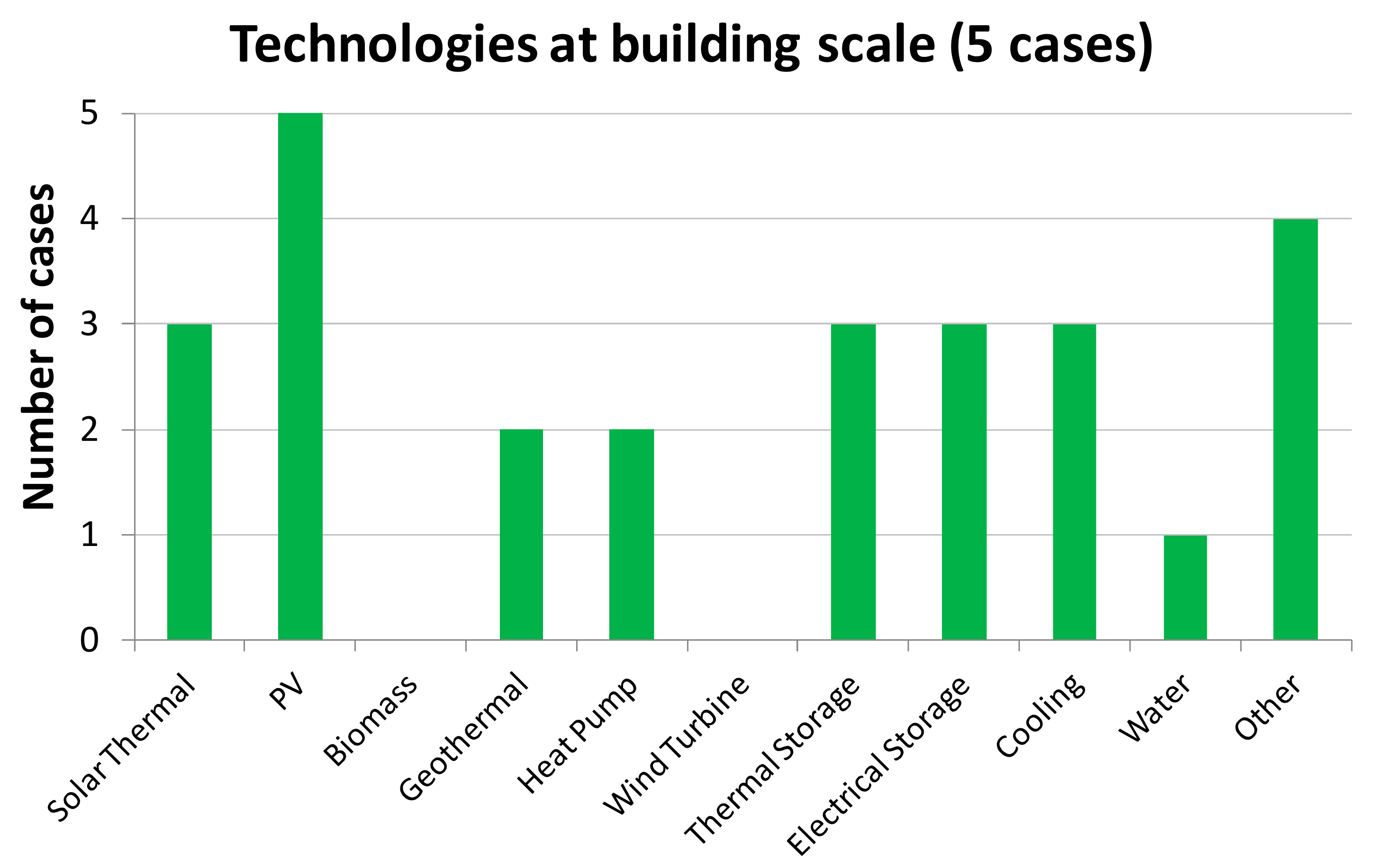
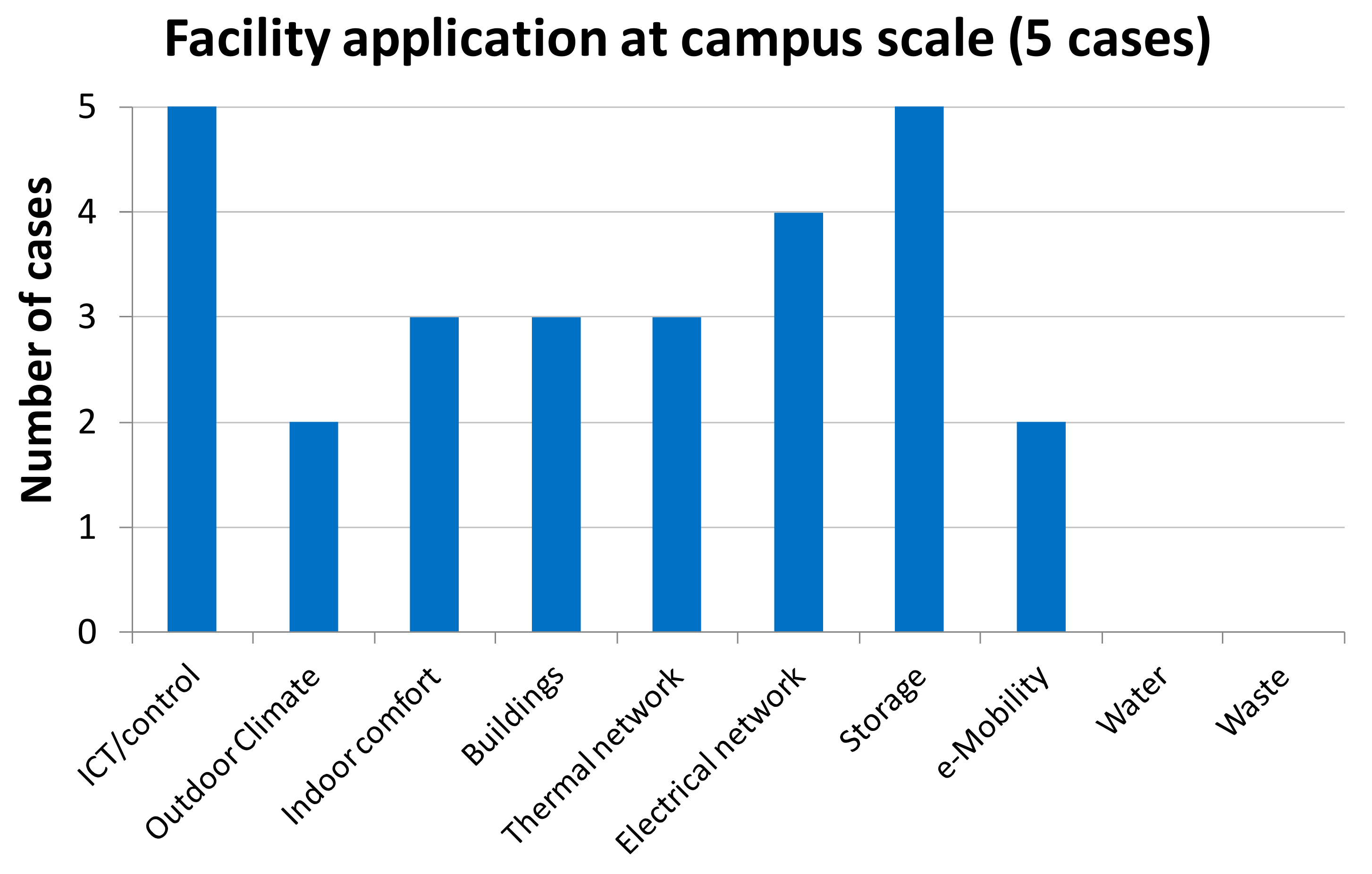
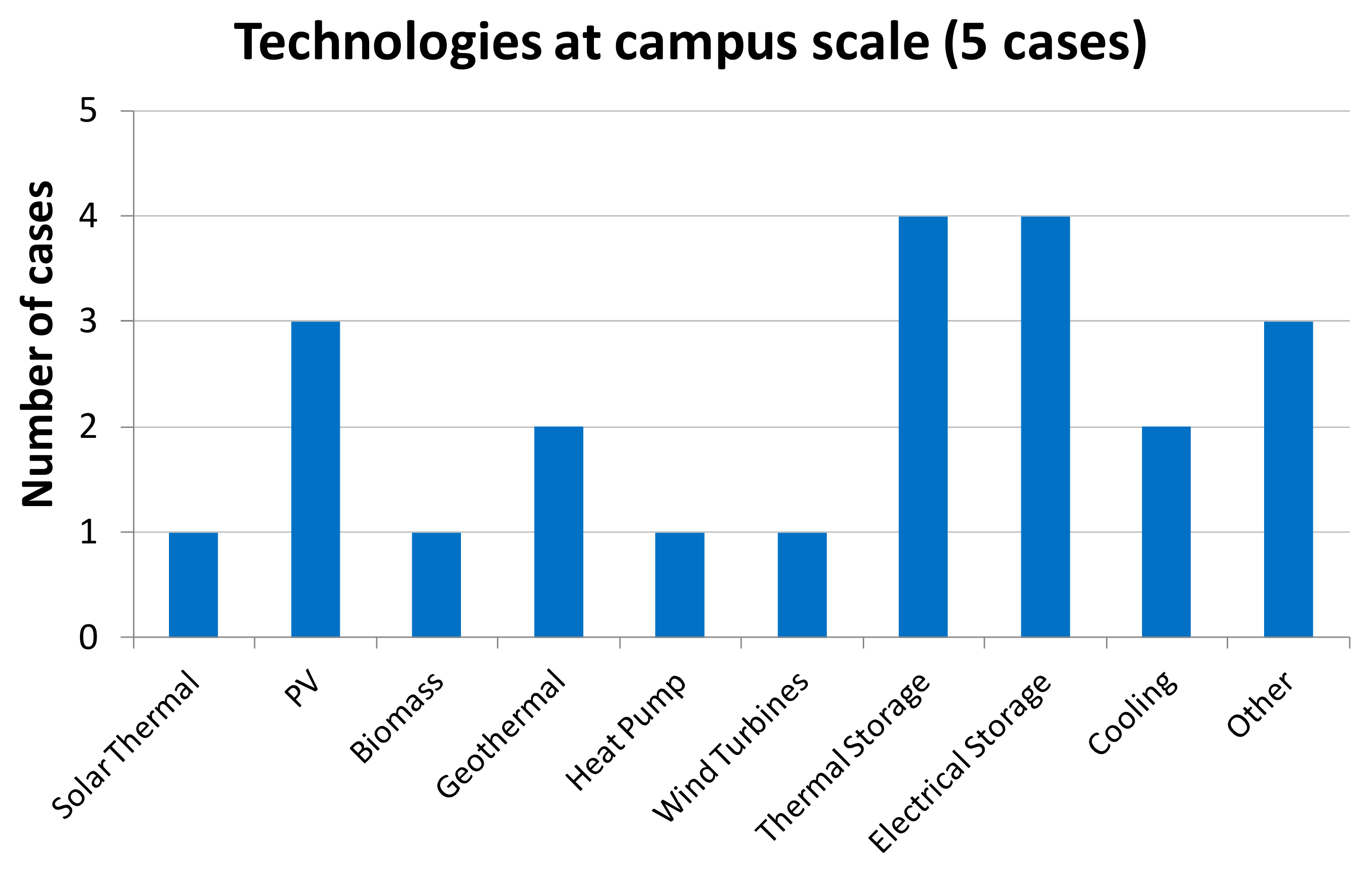
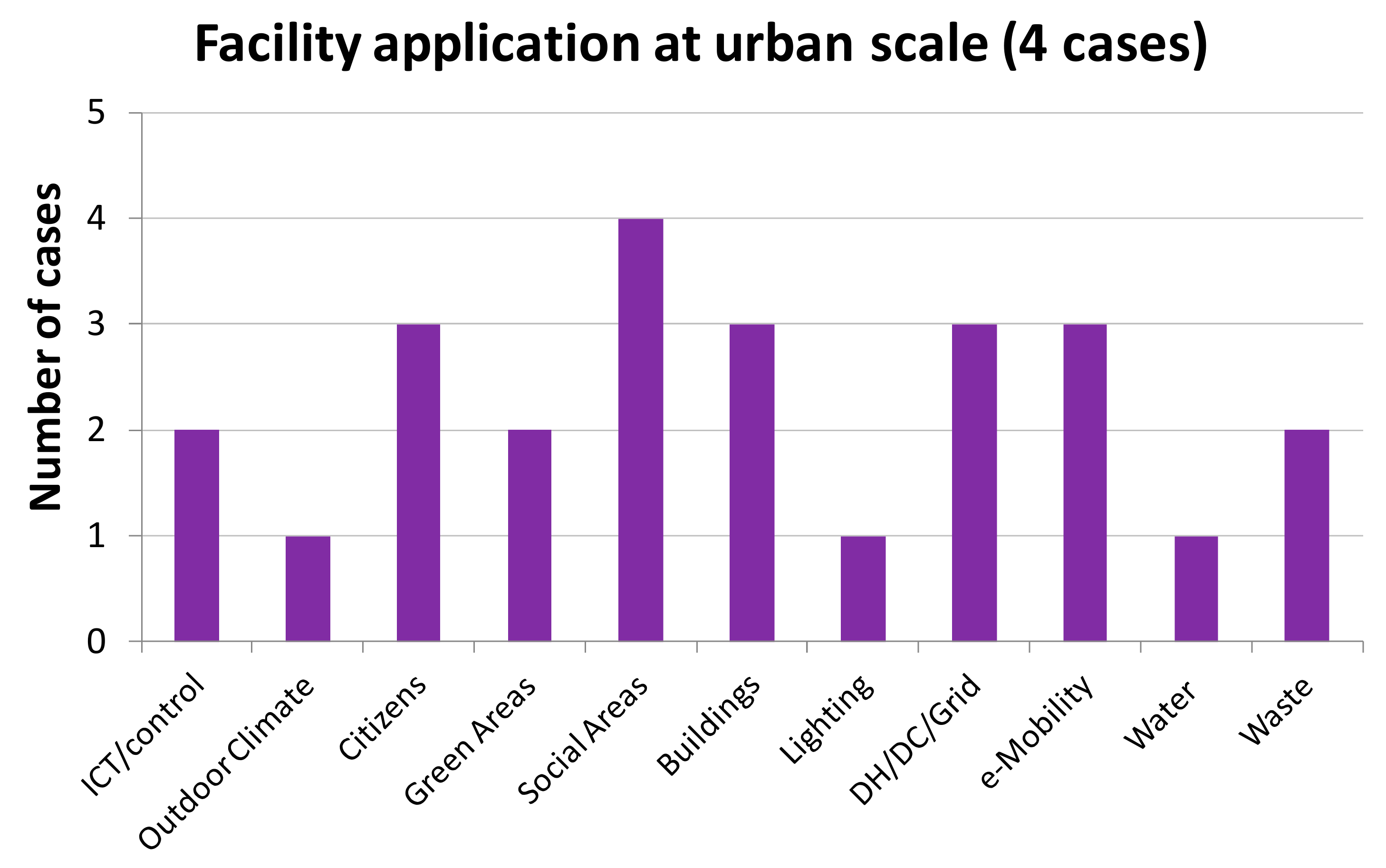
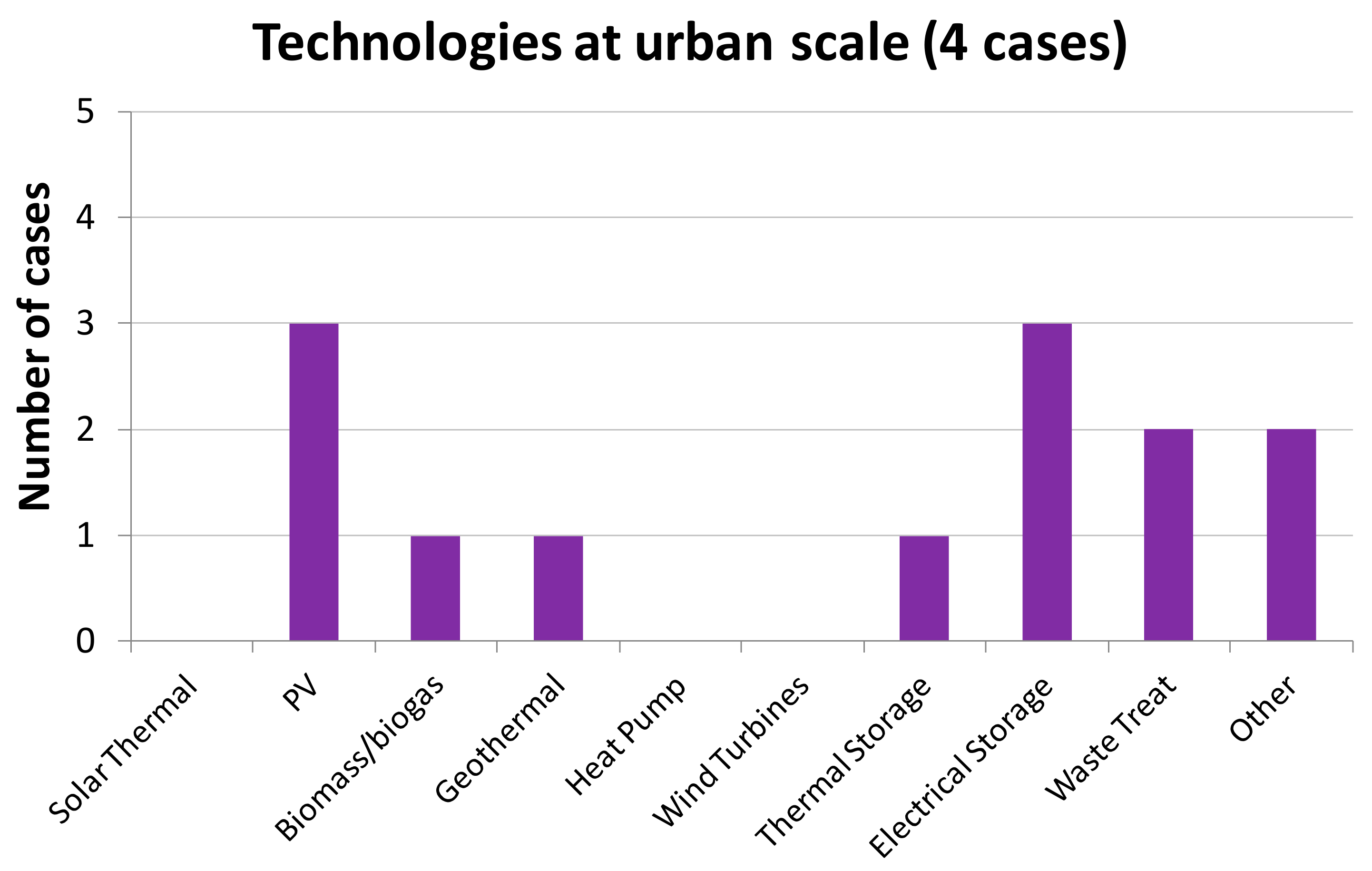
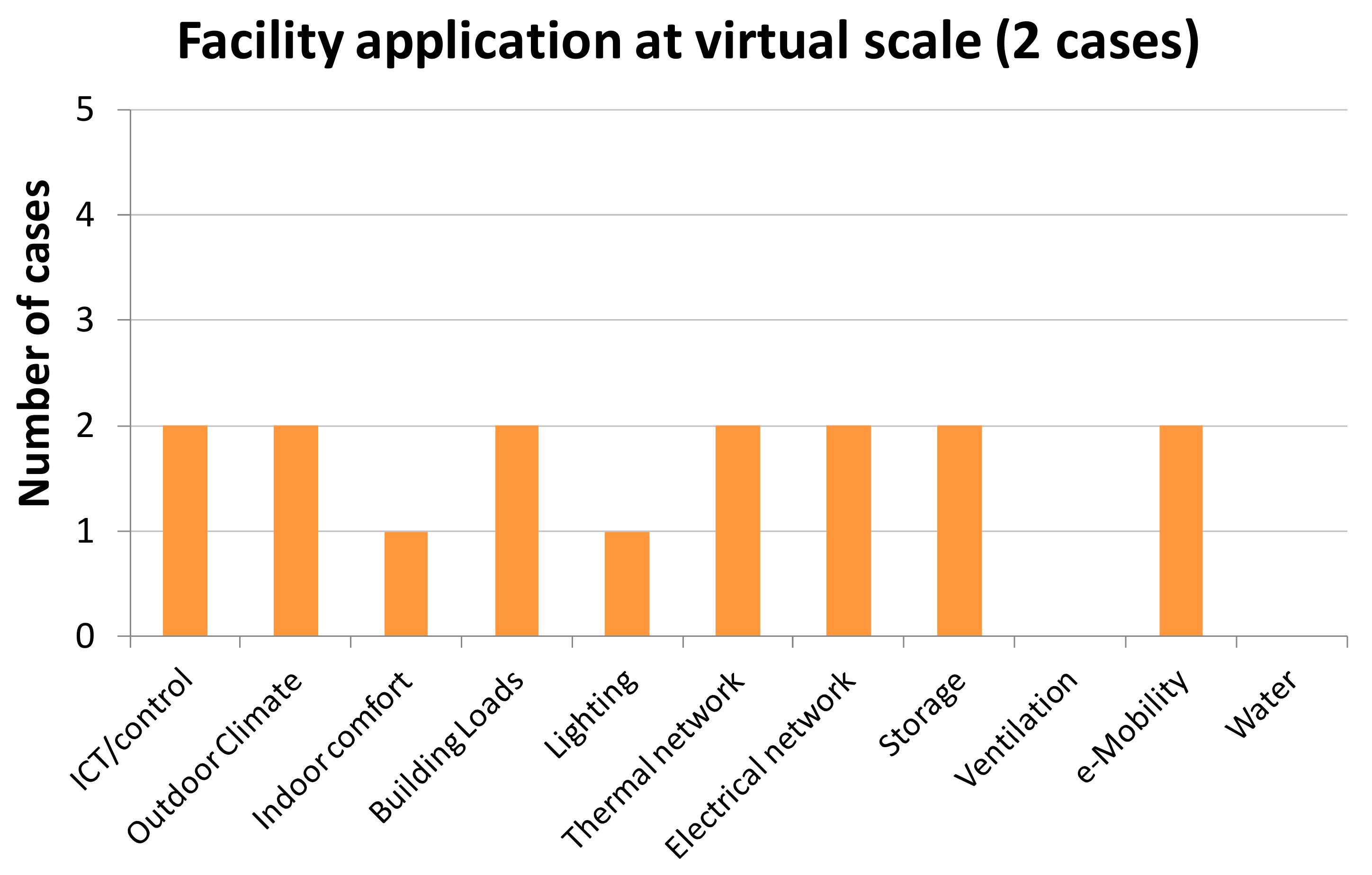
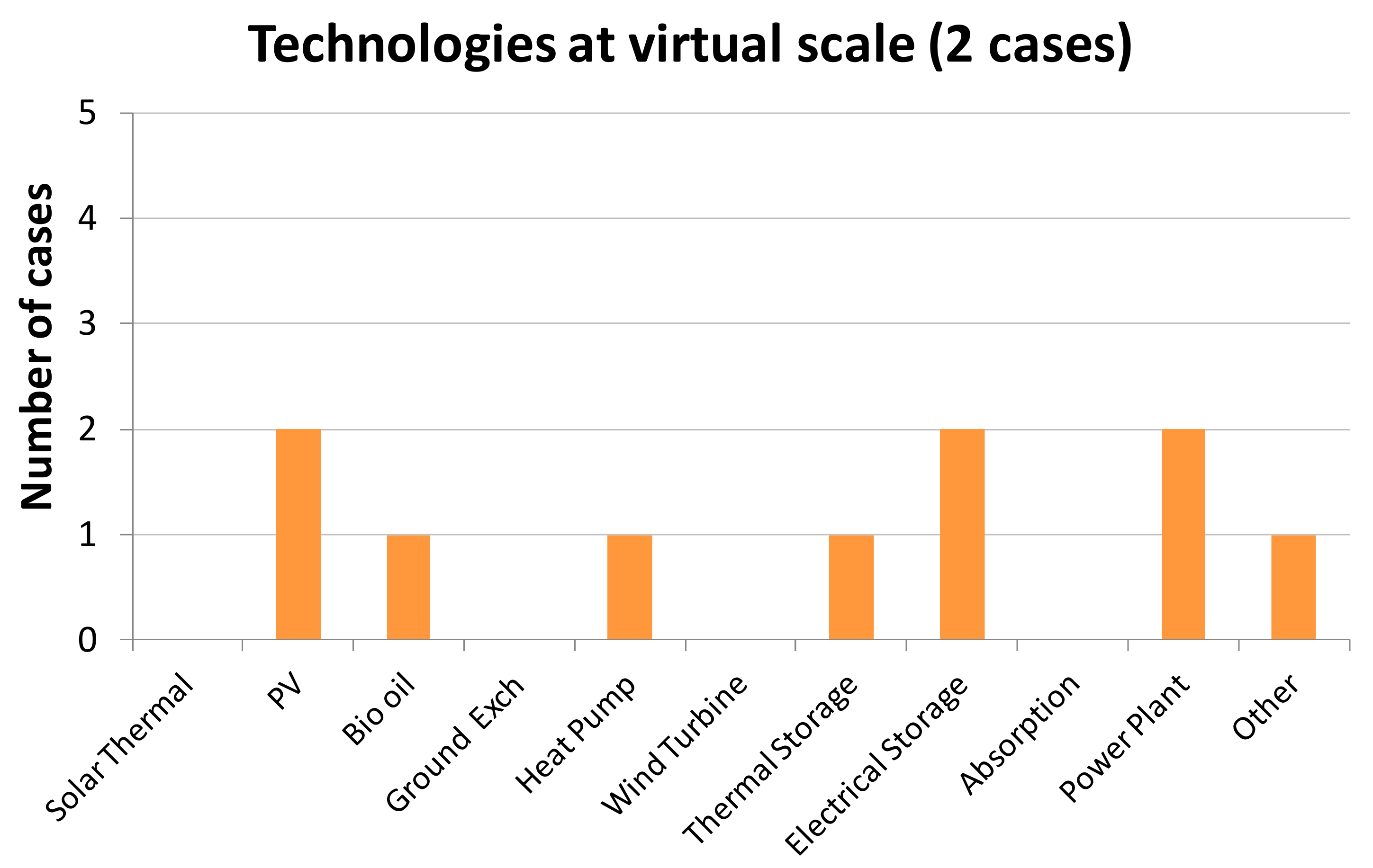
| Infrastructure | Center | Location | Country | Scale of Action | Corresponding Person |
|---|---|---|---|---|---|
| ADRESSAPARKEN | NTNU | Trondheim city center | Norway | Park, community | andrew.perkis@ntnu.no |
| CEDER | CEDER-CIEMAT | Lubia, Soria | Spain | Research campus | raquel.ramos@ciemat.es |
| ED70 | CIEMAT | Madrid | Spain | Building | Ja.ferrer@ciemat.es |
| UPNA | Campus Iberus | Pamplona, Navarra | Spain | University campus | jmolina@unizar.es |
| UniZar | Campus Iberus | Zaragoza, Aragón | Spain | University campus | jmolina@unizar.es |
| UdG. | eXiT RG. | University of Girona, Cataluña | Spain | University campus | roberto.petite@udg.edu/ robert.rusek@udg.edu |
| NZEB_LAB | LNEG | Lisbon | Portugal | Building | laura.aelenei@lneg.pt |
| NIEUWE DOKKEN | Nieuwe Dokken | Ghent | Belgium | District | denieuwedokken.be/contact |
| THOR PARK | Energyville | Genk | Belgium | Community/park | daan.six@energyville.be |
| SEILAB ENERGY | IREC | Barcelona, Cataluña | Spain | Test building | Jsalom@irec.cat |
| SMARTLAB | IREC | Tarragona, Cataluña | Spain | facility | ccorchero@irec.cat |
| UCEEB | Technical University Prague | Buštěhrad | Czech Republic | University test building/facility | michal.kuzmic@cvut.cz |
| ZEB LIVING LAB- | NTNU | Campus Gløshaugen Trondheim | Norway | Building | Kristian.skeie@ntnu.no |
| SPARCS Project | VTT | Leppävaara District, Espoo | Finland | Virtual Power Plant | jaano.juhmen@siemens.com |
| SPARCS Project | VTT | Lippulaiva (Espoonlahti), Espoo | Finland | District | kaisa.kontu@citycon.com |
Publisher’s Note: MDPI stays neutral with regard to jurisdictional claims in published maps and institutional affiliations. |
© 2020 by the authors. Licensee MDPI, Basel, Switzerland. This article is an open access article distributed under the terms and conditions of the Creative Commons Attribution (CC BY) license (http://creativecommons.org/licenses/by/4.0/).
Share and Cite
Soutullo, S.; Aelenei, L.; Nielsen, P.S.; Ferrer, J.A.; Gonçalves, H. Testing Platforms as Drivers for Positive-Energy Living Laboratories. Energies 2020, 13, 5621. https://doi.org/10.3390/en13215621
Soutullo S, Aelenei L, Nielsen PS, Ferrer JA, Gonçalves H. Testing Platforms as Drivers for Positive-Energy Living Laboratories. Energies. 2020; 13(21):5621. https://doi.org/10.3390/en13215621
Chicago/Turabian StyleSoutullo, Silvia, Laura Aelenei, Per Sieverts Nielsen, Jose Antonio Ferrer, and Helder Gonçalves. 2020. "Testing Platforms as Drivers for Positive-Energy Living Laboratories" Energies 13, no. 21: 5621. https://doi.org/10.3390/en13215621
APA StyleSoutullo, S., Aelenei, L., Nielsen, P. S., Ferrer, J. A., & Gonçalves, H. (2020). Testing Platforms as Drivers for Positive-Energy Living Laboratories. Energies, 13(21), 5621. https://doi.org/10.3390/en13215621





